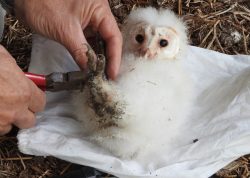Barn Owl Blog – Youngest chick succumbs to heat
June 16, 2017
Update: June 19 2017
Sadly it appears that our youngest owlet has succumbed to the heat and died. Our webcam is obviously giving us a glimpse into all sides of a barn owl’s life, and not all of it is rosy. Please be prepared when you view the live cam.
June 16 2017 – Ringing our 3 growing chicks
Our three remaining owlets are growing rapidly and Mum is starting to leave the nest more. Now that they are big enough, they will be ringed today (Friday 16th). This entails putting a metal ring on their leg with an identification number on. The ring is loose enough to let them grow but small enough that it won’t fall over the talons and prevent them from hunting. They will also be weighed to ensure that they are growing as expected and the new adult wing growth measured.

The ringing does not harm or stress the birds, in fact the Barn Owl chicks are really laid back. Ringing these endangered birds feeds in to British Trust for Ornithology national data and helps to build a picture of how well they are doing. It also helps to identify their age, if the adults are found in a nest box later in life. On average, Barn Owls live up to about 5 years in the wild, but they have been found to be up to 11 years old in Barn Owl boxes.
Ringing the birds also helps to collect data about fatalities. Too often an owl’s life is shortened by accidents on the road (especially high-sided vehicles) and the over-use of pesticides. If you find one of the birds in such circumstance, have a look at its legs and see if there is a ring. If there is, please report it to the British Museum. The licensed ringer will be notified and you will receive some information back about the bird.
